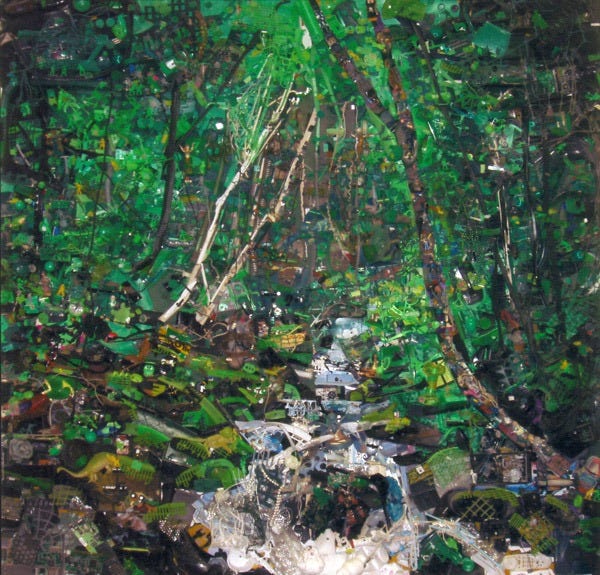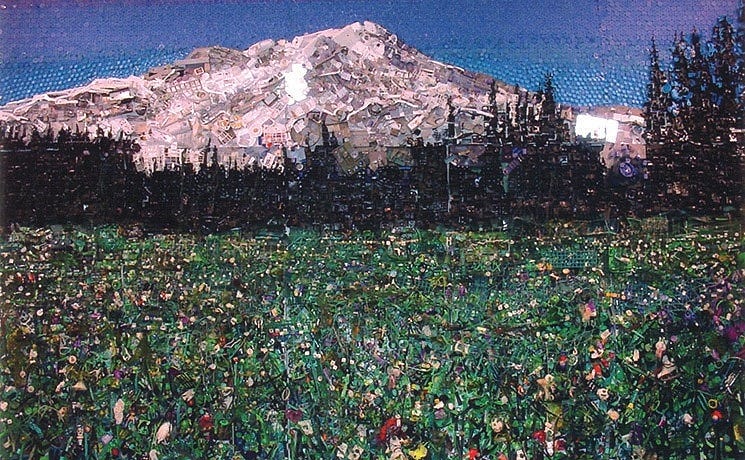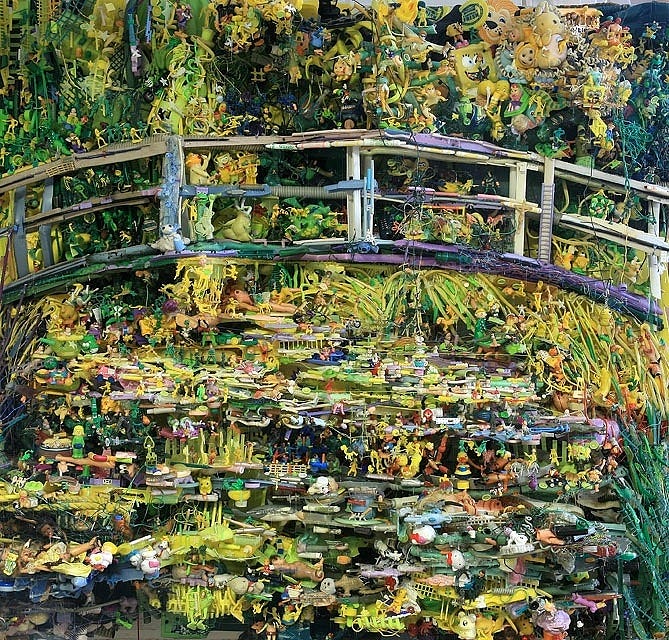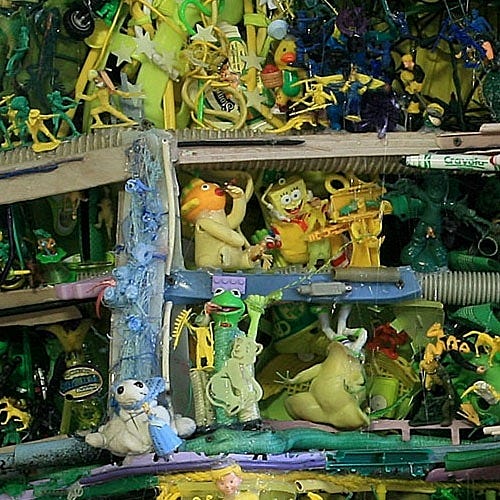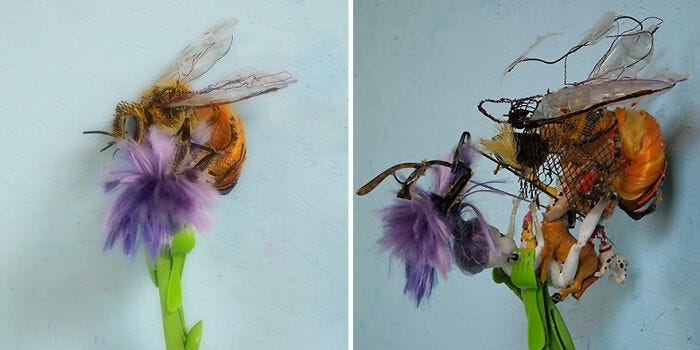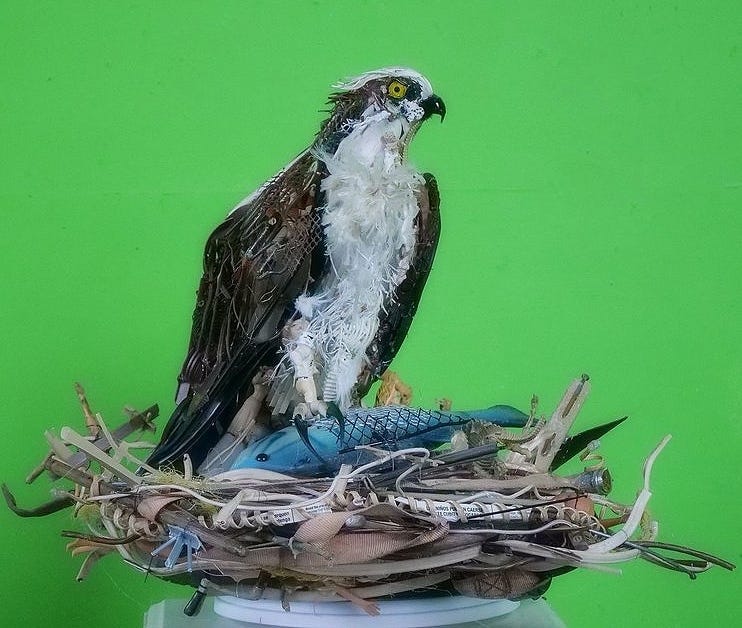Looking at the Masters: Tom Deininger by Beverly Hall Smith
Tom Deininger was born in Boston in 1970. He is a sculptor who works in the style known as assemblage: unrelated, found objects brought together to form a work of art. His sculptures are created with discarded objects that are not biodegradable or recyclable. His work is collected world-wide
He is dyslexic and suffers from ADHD. School was difficult, but he was able to express himself through drawing and making things. Deininger describes himself as “very outdoorsy. I grew up in Norwell, Massachusetts, and I lived in a wooded area with ponds and a river.” He attended Salve Regina University in Newton, Rhode Island, graduating with honors in art. After college he traveled through Europe, Central America, and the South Pacific. He surfed, and he made and sold his art. On this trip to the remote and beautiful beaches of the South Pacific, he saw piles of American plastic trash. He became acutely aware of the damage to the environment created by our consumerist society. Deininger returned to Rhode Island in 1999. He set up a studio in Fall River, Massachusetts. A visit to the Nantucket landfill gave him the idea to make his work three-dimensional, using the thrown-away waste of society.
“Wave 1” (2012)
“Wave 1” (2012) (3’x4’x2.5’) was inspired by Deininger’s love of surfing. Made entirely of found plastic objects, it depicts a large white wave, curling, and pounding the beach–a surfer’s wave. Bits of plastic webbing are visible. This work is small in scale. “Wave 3” (2012) (not shown) (6’x8’x3’) and other works are even larger. He chose to depict what he loved in nature and the destructive effect of consumerism on the environment. He contributes 50% of the sale of his sculptures to the organization Narragansett, Rhode Island Save the Bay.
”Poland Springs” (12’x20’)
“Poland Springs” (12’x20’) (undated) was made from plastic water bottles the Maine corporation Poland Springs uses to contain its product. The waterfalls, plants, and trees of the region create a refreshing view of a heathy and pleasing environment. Pure, fresh, clean water is the product. It takes three liters of fresh water to make one liter of Poland Springs bottled water.
The organization Fortune Brainstorm Green has sponsored annual conferences beginning in 2008 to focus attention on issues of sustainability by bringing together leaders from government, business, and other organizations. Deininger was commissioned to create a 20’x10’ backdrop (not depicted) for one of the conferences. =
“Plastic Paradise”
Deininger once commented, “I go to the beach about four days a week, and I pick stuff up. It’s hunter-gatherer, to be honest. And now I’m getting donations from people on Instagram. They don’t like throwing this stuff away.”
“Plastic Paradise” (12’x20’) (undated) is a depiction of a flower-filled meadow, a tall green forest, a rocky mountain, all set under a clear blue sky. Perhaps Deininger hoped the ironic title would make people think. In a 2024 interview with Yahoo news, he stated, “I don’t think we’re alarmed enough. Everyone’s not alarmed enough, enough of the time, is my fear. We should all be petrified and willing to do whatever it takes.”
‘Stroking Monet” (2010s)
Deininger occasionally selects known works to recreate as assemblages. “Stroking Monet” (2010s) recalls Monet’s “Japanese Footbridge” (1899) in found plastic junk. Deininger dumpster dives, rummages through people’s garbage cans on trash day, and picks things up all the time.
‘Stroking Monet, detail” (2010s)
So, what is it all about? When viewers are able to look at his work up close, they experience a totally new reality. Plastic Sponge Bob Square Pants, Barbies and Barbie parts, Kermit the Frog, abandoned plastic toys, bottle caps, cassette tapes, wire, plastic syringes, plastic bags, and more, all come together to create an entirely different impression. The juxtaposition of parts is funny, sad, alarming, violent, bizarre, and sexual.
Deininger offers his point of view: “And so you’ve got one thing up close and it coalesces into something else all together from a distance. So, just the idea of what is reality, what is truth, has everything to do with perception…. It reminds me of how slippery it can be, what is real and what is true.”
”Honeybee” (undated)
In more recent years, Deininger has begun to create his assemblages with images of birds, fish, and other animals. In his interviews he talks about his process. “Honeybee” (undated) was made from plastic bristles, netting, wire, toy figurines, a plastic German Shepherd, a little man holding a long stick, Shaggy and Scobey-Doo figures, a doll’s head, green plastic forks, and half a pair of sunglasses to represent the eye, among other things.
This double image captures both sides of the sculpture, similar to what a viewer would be able to see when the work is on display. Glueing, wiring, drilling, and pinning are among the processes used. Creating the basic sculpture takes about a week, with more time needed to refine the final image.
Deininger researches each animal: “To cull through hundreds of images of bees and find the one you want because you can clearly see the eye or the thorax—you get to understand the granular details of variation within a species.”
Deininger observes, “We tend to dismiss things that are inexpensive and don’t look at their beauty overall. But when you can take something out of context and put it together with a variety of other things, you can coax a new definition out of it and maybe a new purpose.”
”Osprey” (2023)
Deninger talks about birds: “I’m just really fascinated with them. Fascinated by the physical engineering and also there is a wonder about birds…. It’s often about things coming down from the heavens. Birds occupy this space that isn’t available for us to occupy. I think humans have always been attracted to birds in a spiritual way.”
The subject of the sculpture “Osprey” (2023) (18”x12”x39”) is well-known to those of us who live on the Mid-Shore. The retirement community Heron Point maintains an Osprey nest with a video camera set up so that residents can watch 24/7 during the season.
“Baltimore Oriole” (2023) (5”x11’’x17’’)
It is possible to see both sides of another of Deininger’s sculptures, Maryland’s State bird.
In 2025, Deininger started a permaculture farm, an agriculturally sustainable and self-sufficient ecosystem, to take care of rescued animals.
In several interviews over a period of time he offered his point of view;
“There’s so much junk around us that we can recreate the natural world.” (The Provincetown Independent, 3/212/25)
“Yes, we can call these objects masterpieces.” (Yalik Ak, 7/9/2014)
“You know, nothing changes if we do the same thing over and over again, and just walk into an ecological crisis that is irreversible. It’s about adopting a new perspective.” (Blue Dot Living, 2025)
Beverly Hall Smith was a professor of art history for 40 years. Since retiring to Chestertown with her husband Kurt in 2014, she has taught art history classes at WC-ALL and the Institute of Adult Learning, Centreville. An artist, she sometimes exhibits work at River Arts. She also paints sets for the Garfield Theater in Chestertown.






